As community managers and customer service professionals take to social media for their business strategies, they must also be prepared to handle the unexpected.

While you can't prepare for everything, having a social media crisis management plan ensures your team has the right tools to manage whatever arises.
Download the Template for Free
These problems could include major product issues, a marketing faux pas, or a global pandemic.
Each of these scenarios deserves reasonable and empathetic responses from your brand, but if your team doesn't have a framework for what to say, when, or how, they'll be left floundering.
So if you're working on a customer service team or handling outbound communications, you need the right answers to communicate with customers during a crisis.
Table of Contents
- What is a social media crisis?
- Social Media Crisis Management
- Social Media Crisis Management Plan Template
- Social Media Crisis Management Plan
- Social Media Crisis Examples
- Social Media Crisis Management Examples
- 10 Social Media Crisis Management Tips
What is a social media crisis?
I'm sure we've all seen an unfunny or weird tweet from a business before, but not all social media fails constitute a crisis. To that end, not all crisis management stems from a social media faux pas.
However, one thing is clear: When things go south, it's time to implement your social media crisis management plan.
A social media crisis is an online activity that can damage a brand's or major stakeholder's reputation by posting or sharing offensive, distasteful, or even dangerous information.
Social media crises can erupt from a business posting or sharing content that:
- Belittles or mocks a group of people.
- Insensitively uses figures or events to sell products.
- Spreads false or dangerous information.
- Is questionably slanderous.
Beyond posts themselves, social media crises can also include employee misconduct or errors that are then spread online or other happenings that can make headlines for the wrong reasons.
The result of such actions can be a nightmare for any marketing team.
Common repercussions include nasty comments from customers, unhappy customers voicing their concerns, and a marketing faux pas permanently documented on the internet even after it's deleted.
And since people make decisions with their pocketbooks, it's absolutely vital that you get out in front of things quickly.
Social Media Crisis Management
Whether a crisis occurs online or off, you can expect a social media response from your customers. In fact, studies show that 80% of customers use social media to engage with a brand.
Social media is becoming the preferred method of communication because it empowers consumers to post a review instantly for all your followers to see.
If your brand makes a mistake, customers will quickly take to their phones to tweet or post about the issue.
These comments can snowball and escalate a problem into an alarming crisis. To that point, 37% of consumers who use social media to complain or question brands expect to get a response in under 30 minutes.
This is why it's important to have a plan in place.
Benefits of Social Media Crisis Management
The good news is that social media can be a powerful tool for managing a business crisis.
Mass Distribution
Social media allows you to communicate with nearly your entire customer base over one or two platforms. Your company can quickly broadcast a message and get ahead of a crisis when needed.

To that end, by also including how you plan to do better, you build trust with your audience.
Midwest utility WE Energies had an unexpected disruption to power and immediately shared a critical request to social media.
They used the above Facebook post to keep their customers informed, updating it as more information became available.
After publishing, they were able to get notices to the media and customers via email and text. (The shortage was resolved the following morning.)
Personalized Messaging + Problem-Solving
Social media allows you to speak directly with customers using direct messaging or commenting. If one customer has an issue, your customer service team can respond instantly through private or public messages.
If the customer posts publicly on your timeline, an effective response from your customer service team can be a positive example of your team's credibility.
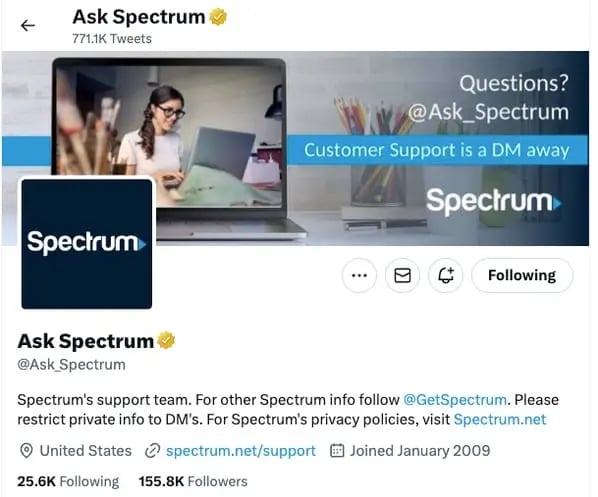
Many brands take to Facebook and Twitter messaging to handle problems in addition to traditional channels.
Spectrum is one of many that people can message to get quick, convenient, and effective responses to their questions or concerns.
Create Transparency
Social media is often the first stop for consumers when news breaks. And brands that do social media well capitalize on the opportunity to build trust by delivering transparency to their audience.
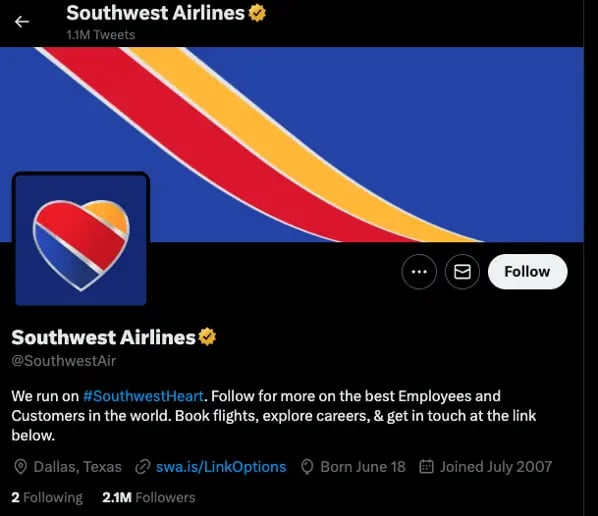
Southwest Airlines is well known for using social media to communicate with their customers, delivering updates, and giving them information about where to go for more information.
Now that we know how proper management can impact a company, we'll break down how your business can create a crisis contingency plan and integrate it into your customer service team.
But before diving in, we have a free resource to help you prepare for almost any crisis.
Social Media Crisis Management Plan Template
From negative comments to natural disasters, it's essential to have a proper response plan for your social media channels. This guidewill help you solve tough problems quickly while avoiding damage to your company's reputation.
In this free PDF guide and Excel template, you'll learn:
- How to become an expert problem solver
- The differences between a problem and a crisis
- What to do when a problem becomes a crisis
- How to create your very own crisis management plan
Social Media Crisis Management Plan
Whatever the challenge, having a social media crisis management plan can be essential to your team's success.
If you're not sure where to start, take a look at the outline below. Each item is a detailed step for creating your social media crisis management plan.
1. Identify the source of the problem.
The first step to crafting a social media crisis response is identifying the problem and locating where it originated. Not every social media crisis stems from an online source.
Often something that happens in popular culture or news events results in a social media uproar. Finding out what caused the crisis can help you determine the correct response and the appropriate channels to distribute it.
If the problem does occur offline, you'll also want to look at the current status of your social media accounts. Has there been a response? Even if there isn't one yet, you have to expect there's going to be one.
If customers are already posting on your timelines, then:
- Assess the damage that's been made thus far.
- Look at which social media accounts it's affecting.
- Try to identify any trends in the comments.
Evaluating the situation before taking action ensures that you're creating a long-term plan to handle the crisis.
While you want to manage the crisis appropriately and with transparency, the last thing you want to do is a knee-jerk reaction that inflates or worsens the problem you're facing.
2. Categorize the issue as a crisis or problem.
The next step in social media crisis management is to determine the severity of the issue. Is it a problem? Or is it a crisis?
You may think that's semantics, but a key difference between a problem and a crisis determines the response you'll want to deliver.
A problem is a minor customer service issue that can be resolved using standard service tactics. Whether a resolution occurs publicly or privately, it's important to ensure the customer is satisfied.
Depending on the problem, your company may solve this with a coupon or discount that's sent to a customer who writes an unhappy comment or post.
In comparison, crises affect larger audiences and require a special response from your business to prevent escalation. It's important not to mislabel a problem as a crisis, as this can bring negative attention to your brand.
Social media is a public forum, and users can watch your company formally apologize for a seemingly minor issue.
If you're unsure if it's a crisis, begin with your standard customer service approach, but be prepared to escalate the issue to a crisis if needed.
3. Use an internal flowchart to execute actions.
Once you have established the right course of action, the next step in creating a social media crisis management plan is execution.
Since crises tend to escalate, it helps if your team plans a flowchart for what to do if a crisis becomes more severe. We've included one example of what this can look like in the image below.
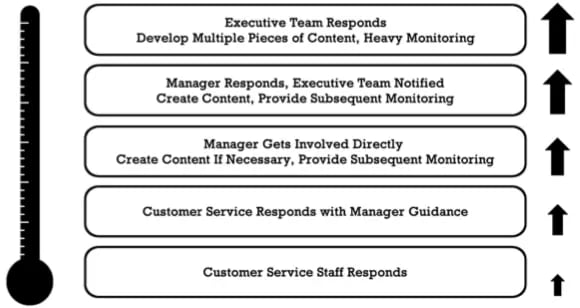
As you can see, standard responses using the customer service rep and manager are at the lower end of the scale. As the crisis intensifies, additional measures are taken to deliver an appropriate response.
Business executives can use this flowchart during the crisis as a guide to monitoring the status of the situation.
One component that needs to be added to this flowchart is pausing or editing future content.
- Note: As a crisis escalates, you may need to adjust your publishing schedule to demonstrate a complete focus on the issue. Consider pausing scheduled posts, ads, and marketing emails to show your customers that you're truly devoted to resolving the crisis.
It's important to remember that this plan will vary depending on the crisis you're faced with, your business, products, and services. Some situations require different steps to produce the most effective response.
Before planning to handle a social media crisis, we first need to know what it looks like. In the next section, we'll highlight some notable social media crises that affected real-life businesses.
Social Media Crisis Examples
Social media crises are often unexpected and can occur at any moment. Big and small brands are susceptible to crises that can significantly impact their reputations.
Here are a few real-life social media crises that can help you become more familiar with these situations.
1. Undermining Customers
A U.S.-based event management company Ticketmaster manages a significant percentage of ticket sales in the country.
When Taylor Swift, one of the decade's biggest stars, put tickets for her 2023 tour up for pre-sale, disaster struck.
Widespread reports surfaced of fans not being able to finalize their purchases, with the company crashing during checkout.
Because the company managed the presale codes, they had advance notice of how many people would be seeking tickets, and they ultimately failed.
A huge public outcry prompted an antitrust probe and an angry Instagram post from Swift.
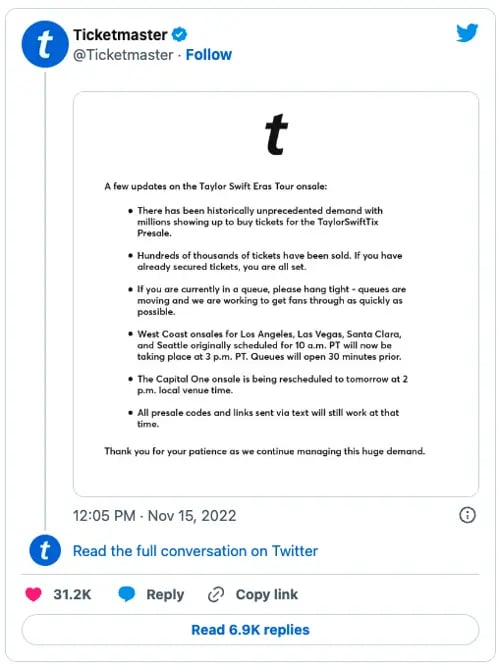
2. Inappropriate Marketing Messages
High-profile fashion brand Balenciaga came under fire for its ads featuring children holding teddy bears in highly sexualized attire. Because this came on the heels of a scandal with Kanye West, it did further damage to the brand.
In addition to pulling the ads and apologizing for them, the brand admitted to a severe miscalculation and agreed that the campaign was offensive. However, they were slow to take action and filed a lawsuit against the photographer.

3. Distasteful Comments From an Executive
There is no better example of this than Elon Musk's takeover of Twitter.
In addition to making wild assumptions and accusations before and after purchasing the social media platform, his sweeping staffing cuts and other gaffes caused calls to boycott Twitter.
The ongoing controversy continues with chaotic product releases, the development of a "hardcore" work culture where employees are expected to sleep onsite, and more.
In addition to Musk's reputation taking a nosedive, Twitter is losing credibility, and Tesla has been under the microscope.

Successful social media crisis management begins with developing a strategy that proactively prepares for potential problems.
Social Media Crisis Management Examples
Slack's Outage Response
Slack is a popular online messaging platform that experienced a huge outage in February 2022. During the outage, they published frequent updates to keep people in the loop.
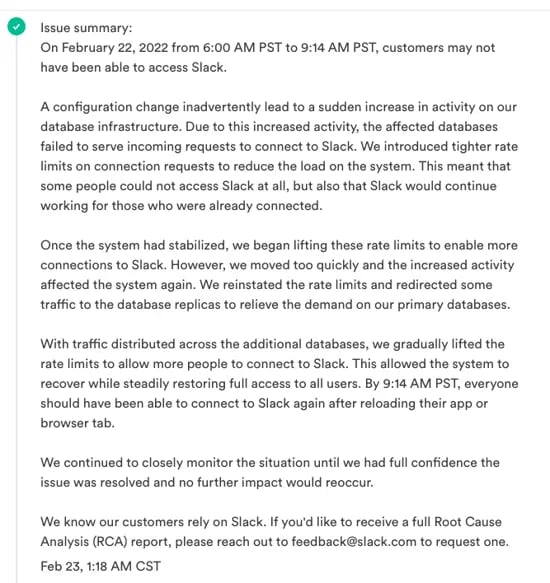
The brand also went to Twitter to share a lighthearted yet deeply sincere apology.
Why It Worked
Slack was incredibly transparent during the problems. They acknowledged what was happening, kept their audience in the loop, and followed through until it was resolved.
What's more, they followed up publicly after the fact with a sincere apology.
Burger King — Who belongs in the kitchen?
On International Women's Day, Burger King UK posted a cringeworthy tweet, "Women belong in the kitchen." Unsurprisingly, this led to a huge uproar on social media, with people questioning who authorized this post.
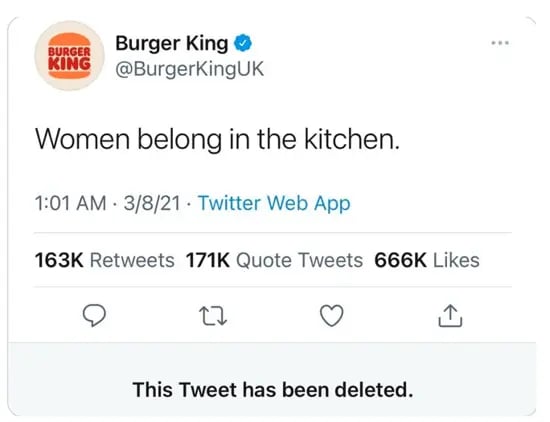
Burger King immediately took action, deleting the post and publishing the below apology:
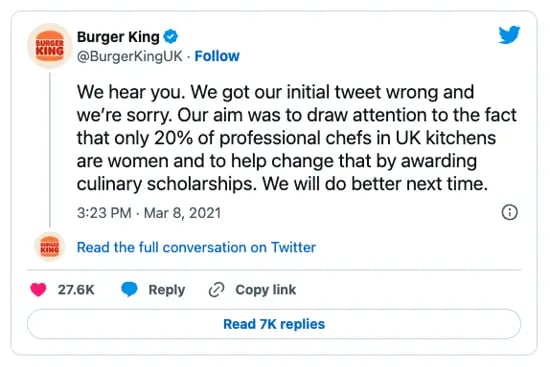
Why It Worked
While the gaffe was certainly offensive for many, by taking ownership of their mistake, Burger King was able to head off the PR nightmare that it could have been.
Moreover, their heartfelt apology and explanation of what they intended to say helped.
People miscommunicate all the time, and people were more or less forgiving of Burger King. However, their commitment to learn from their mistakes was the icing on the cake.
10 Social Media Crisis Management Tips
1. Protect and restrict social media login information.
This may seem like a no-brainer, but crises can arise when an account gets into the hands of the wrong people. A 2021 Norton Cyber Safety Report claims that nearly 14% of social media users have dealt with unauthorized activity on their accounts.
Pro tip: Ensure your marketing team is taking precautions to minimize this risk and have a message ready to share when the account has been reclaimed.
2. Engaging in social listening can help you do the right thing.
Your marketing team may have never dealt with a social media crisis before — it's daunting.
Even without a full-fledged plan in place, your audience or the public may be saying exactly what your team needs to hear to handle the situation beneficially.
Closely monitor the responses your business receives and see how you can combine their suggestions with meaningful action, and your reputation will have a better chance of survival.
Pro tip: Create an action plan based on these suggestions and tell your audience how you're adapting them.
3. Pause any scheduled social media campaigns.
Before a crisis is resolved, your marketing team must halt its scheduled campaigns. It's not ideal, but nothing comes off as more tone-deaf than promoting a product while failing to acknowledge a serious problem.
All further communication must be planned, consistent, and appropriate in tone. And a pre-scheduled post won't fulfill those criteria.
Pro tip: It's not enough to simply pause campaigns. Revisit everything you have planned to ensure that if it's insensitive, you pull it for good.
4. Learn from it and add guidelines for future social media usage.
The biggest takeaway from any crisis is that you should work to prevent it from happening again.
Reflect on the successes and pitfalls of your marketing and service teams' crisis management. By sharing takeaways with different stakeholders, you can devise social media crisis management plans that will prepare your business for anything that may arise.
Pro tip: Your lessons can serve as an opportunity to forge better relationships with your audience. Consider creating a social post about what you learned and how you adapted to build trust.
5. Respond quickly, but not too quickly.
You have to move fast to get in front of the crisis to show you're aware and taking steps to mitigate it. That means you don't want to sit on the sidelines while the problem grows and wait to take action until it's a full-blown crisis.
However, you don't have to put together a post the second you hear about it. Instead of a knee-jerk reaction, evaluate the situation and think about your response so you don't exacerbate the situation.
Pro tip: Create a fill-in-the-blank template you can use to create an initial response post, even if it's simply acknowledging the situation, stating that you're investigating it, and will update soon. It may not work for every situation, but it gives you a starting point.
6. Prioritize transparency.
After realizing there's a problem, formulate your response. Let your audience know as soon as possible that you're aware of the situation and what you're doing about it.
Even if the first step is to investigate the problem, that's an exceptional first step. Tell them where they can get updates and how frequently to expect them. Then follow through.
Transparency builds trust.
Pro tip: Consider a specific page on your website that you can update frequently. Even if your social media account doesn't get updated every 15 minutes, your audience still has somewhere to look for updates.
7. Be authentic.
Your audience knows when you're paying lip service to placate them. The beauty of social media is that it allows you to be more personal. So use this to share your true apologetic feelings and appreciation for your audience.
Pro tip: If it's appropriate to incorporate a dose of humor (especially the self-deprecating variety), you can build empathy and understanding with your company.
8. Don't assign blame elsewhere.
Above all, you must take responsibility for the problem. A critical part of your social media crisis management plan should include how you'll acknowledge fault.
After all, apologies that start "We're sorry, but…" lose trust and build angst faster than almost anything else you can say. Instead of passing the buck, a simple "We screwed up. Please forgive us?" can go a long way toward beginning to repair the damage.
Pro tip: Include how you plan to do better, which helps you build trust with your audience.
9. Engage with your audience.
You probably can't respond to every comment mid-crisis because your team will be all hands on deck to resolve it. However, as time allows, engage with your audience as much as possible.
Pro tip: Don't simply post a blanket statement with every response. Instead, by taking a moment to acknowledge and empathize with the comments you do respond to, you can personalize your response and show your audience that you really do care.
10. Communicate internally as well as externally.
It's absolutely essential to keep your audience in the loop. However, there's another group of people you can't forget — yours.
Your customer service team is on the front lines of customer responses to the crisis, and you need to equip them with the tools they need to handle the situation.
One of those tools is accurate information. The only thing worse than misinformation spread by people outside your company is when it's spread by people on your team — internally as well as to your customers.
Failing to include updating your internal team in your social media crisis management plan is simply not an option. It's a recipe for disaster.
Pro tip: To head off an internal crisis and the one you're handling, give your team information, tell them what they can share, and present them with language to share it. Doing so ensures that everyone on your team contributes to a consistent message and will help get your brand on track.
Make Your Crisis Plan Before You Need It
Regarding a social media crisis, it's important to respond as quickly as possible.
Owning responsibility for the action, apologizing, and perhaps poking fun at yourself (if appropriate) can help your customer service teams respond to incoming inquiries as quickly and effectively as possible.
Your social media crisis management plan isn't just a nice, shiny tool in your toolbox. It's a must in today's social media-centric world.
Editor's note: This post was originally published in May 2015 and has been updated for comprehensiveness.
![→ Access Now: Social Media Customer Service Template [Free Tool]](https://no-cache.hubspot.com/cta/default/53/07102c64-cd2f-4581-b6dc-0ee62a108842.png)


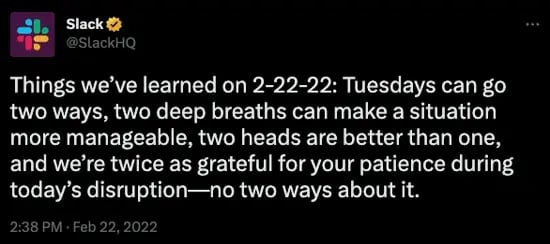


![De-Escalation Techniques: 19 Best Ways to De-Escalate [Top Tips + Data]](https://blog.hubspot.com/hubfs/de-escalation-techniques_2.webp)



![What Is Contingency Planning? [+ Examples]](https://blog.hubspot.com/hubfs/contingency-planning.jpg)
![What Is A Business Continuity Plan? [+ Template & Examples]](https://blog.hubspot.com/hubfs/business-continuity-plan.jpg)
![What Is Reputational Risk? [+ Real Life Examples]](https://blog.hubspot.com/hubfs/212_Reputational Risk.png)
